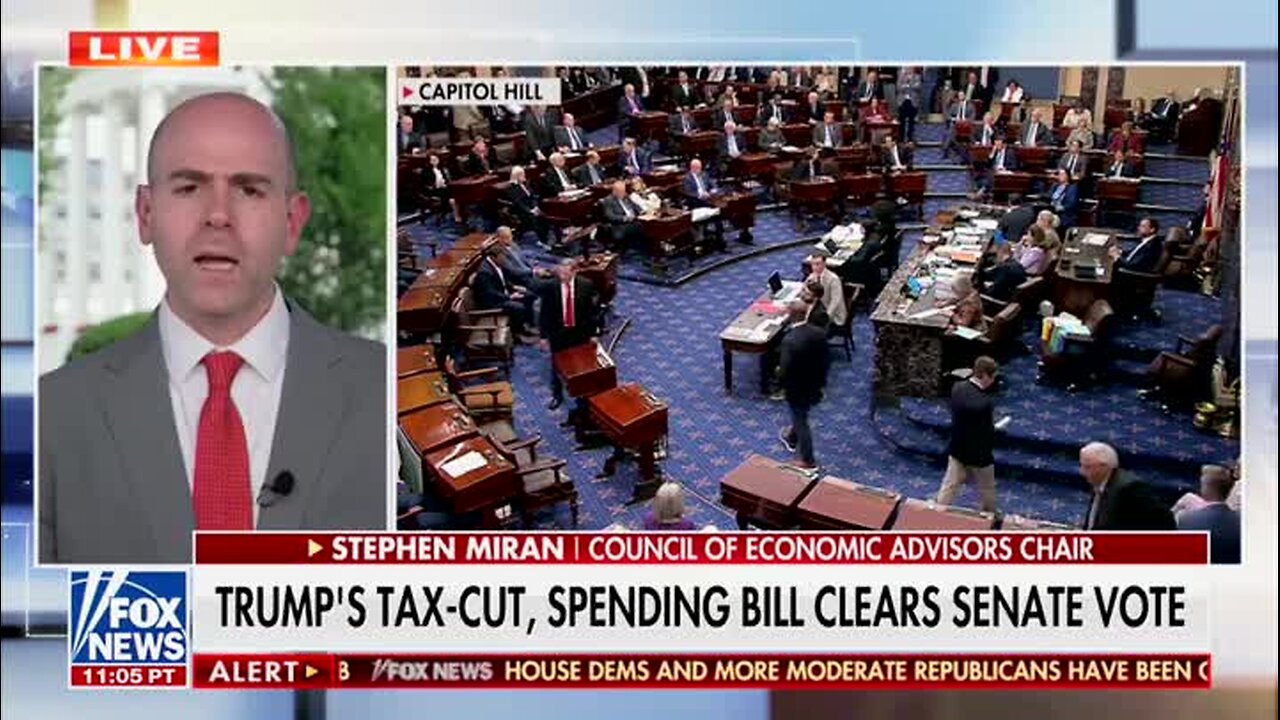Premium Only Content

Stephen Miran: There’s Going To Be a $3 T of Tariffs Revenue, Which Is Good for Bringing Down the Deficit
Smith: “There’s a lot of calculations there that you have made. It has not convinced some, including Andy Harris from the House Freedom Caucus. He joined us last hour and said this. I’ll get you to respond.”
[Clip starts]
Harris: “This is not ready for prime time. We support the president’s agenda. The president’s agenda was not to raise the deficit by three quarters of a trillion dollars over the next 10 years. The bottom line is now the House is going to have its say. This is not going to sail through the House. We’re going to have to negotiate with the Senate one more time, and that’s just appropriate. That’s the way the legislative process works and the way it should work on a bill of this size.”
[Clip ends]
Smith: “So, Stephen, how do you respond to him?”
MIRAN: “So what I’d say is, number one, voting against this bill is effectively voting for the biggest tax cut like in history, and that would be really bad to stick American workers and American businesses with a $4 trillion tax cut that will send the economy careening into recession. But what I’d also say to him is that the deficit will come down. The deficit will come down through economic growth and other policies that we’re implementing. Let me tell you all the things that are not included in the CBO score that are getting ignored by the doubters in this process. There’s better revenue from economic growth that I just mentioned a moment ago. That’s about $4 trillion. There’s going to be about $3 trillion of tariff revenue coming in, too, that because they don’t come in through the legislative process, they don’t get counted in the score. But those $3 trillion are as good as any other dollars for bringing down the deficit. There’s about a trillion and a half dollars of further administrative costs. These are things like reduced headcount at federal agencies, the government becoming more efficient, doing more with less. And there’s also another about a trillion and a half dollars of reduced interest expenses because we’re borrowing less for all the other things. You add all this up, you get to about $8.5 to $11 trillion of growth across all of these different means of — sorry, $8.5 to $11 trillion of reduced deficit from all of these means of bringing the deficit down. And it’s all in all, combined, extremely powerful. And so it’s very, very powerful deficit reduction. It’ll bring the debt-to-GDP ratio down by over 20 percentage points relative to what the CBO expects.”
-
 1:08
1:08
Grabien
6 hours agoKat Cammack on Another Gov’t Shutdown: We Won’t Have the Votes in January for a Redo of a Ridiculous Shutdown
13 -
 LIVE
LIVE
ttvglamourx
4 hours ago $0.16 earnedSUSSY SUNDAY !DISCORD
105 watching -
 LIVE
LIVE
slychapter3
2 hours ago🔴🏝 Using Christopher Columbus's Spy Glass🔭!! Survival: Fountain of Youth!!🔴
30 watching -
 32:41
32:41
Tactical Advisor
4 hours agoNew Red Glock? | Vault Room Live Stream 045
40.9K8 -
 LIVE
LIVE
Coldbiscuits
2 hours ago🔴I Came Here to Fight Robots and Miss Shots | THE ARC RAIDER
33 watching -
 LIVE
LIVE
Major League Fishing
3 days agoLIVE! - Fishing Clash Team Series: Summit Cup - Day 1
638 watching -
 4:38
4:38
Talk Nerdy Sports - The Ultimate Sports Betting Podcast
6 hours agoNFL SUNDAY — Top 10 Locks You NEED to See (Nov 17)
30K -
 18:03
18:03
Nikko Ortiz
4 hours agoNikko Ortiz Night Routine...
22K10 -
 21:37
21:37
Forrest Galante
17 hours ago6 Deadly Sea Monsters That Actually Exist
123K9 -
 LIVE
LIVE
JdaDelete
5 hours ago $2.53 earnedElden Ring | First Playthrough Episode 10
117 watching